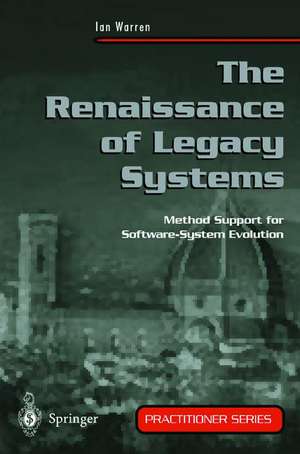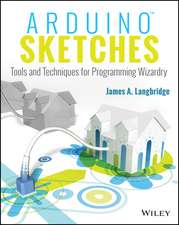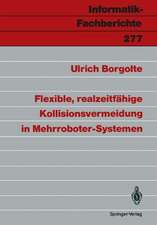The Renaissance of Legacy Systems: Method Support for Software-System Evolution: Practitioner Series
Autor Ian Warren Contribuţii de D. Avallone, M. Breuer, J. Favaro, J. Ransom, E. Tryggeseth, C. Villermainen Limba Engleză Paperback – 6 feb 1999
Din seria Practitioner Series
- 20%
 Preț: 337.52 lei
Preț: 337.52 lei - 20%
 Preț: 645.14 lei
Preț: 645.14 lei - 20%
 Preț: 333.54 lei
Preț: 333.54 lei - 20%
 Preț: 336.86 lei
Preț: 336.86 lei - 20%
 Preț: 332.24 lei
Preț: 332.24 lei - 20%
 Preț: 326.28 lei
Preț: 326.28 lei - 20%
 Preț: 344.76 lei
Preț: 344.76 lei - 20%
 Preț: 330.56 lei
Preț: 330.56 lei - 20%
 Preț: 333.04 lei
Preț: 333.04 lei - 20%
 Preț: 336.67 lei
Preț: 336.67 lei - 15%
 Preț: 646.94 lei
Preț: 646.94 lei - 20%
 Preț: 330.10 lei
Preț: 330.10 lei - 20%
 Preț: 332.24 lei
Preț: 332.24 lei - 20%
 Preț: 329.76 lei
Preț: 329.76 lei - 20%
 Preț: 327.77 lei
Preț: 327.77 lei - 20%
 Preț: 341.95 lei
Preț: 341.95 lei - 20%
 Preț: 328.42 lei
Preț: 328.42 lei - 20%
 Preț: 331.58 lei
Preț: 331.58 lei - 20%
 Preț: 326.13 lei
Preț: 326.13 lei - 15%
 Preț: 647.08 lei
Preț: 647.08 lei -
 Preț: 383.71 lei
Preț: 383.71 lei - 20%
 Preț: 355.14 lei
Preț: 355.14 lei
Preț: 328.27 lei
Preț vechi: 410.34 lei
-20% Nou
Puncte Express: 492
Preț estimativ în valută:
62.82€ • 64.81$ • 53.17£
62.82€ • 64.81$ • 53.17£
Carte tipărită la comandă
Livrare economică 05-19 martie
Preluare comenzi: 021 569.72.76
Specificații
ISBN-13: 9781852330606
ISBN-10: 1852330600
Pagini: 200
Ilustrații: XIII, 182 p. 73 illus.
Dimensiuni: 155 x 235 x 11 mm
Greutate: 0.3 kg
Ediția:Softcover reprint of the original 1st ed. 1999
Editura: SPRINGER LONDON
Colecția Springer
Seria Practitioner Series
Locul publicării:London, United Kingdom
ISBN-10: 1852330600
Pagini: 200
Ilustrații: XIII, 182 p. 73 illus.
Dimensiuni: 155 x 235 x 11 mm
Greutate: 0.3 kg
Ediția:Softcover reprint of the original 1st ed. 1999
Editura: SPRINGER LONDON
Colecția Springer
Seria Practitioner Series
Locul publicării:London, United Kingdom
Public țintă
Professional/practitionerCuprins
1. Background.- 1.1 Legacy Systems.- 1.2 System Change.- 1.3 System Evolution.- References and Further Reading.- 2. Renaissance: a Method for System Evolution.- 2.1 The Process Model.- 2.2 Information Management.- 2.3 Responsibilities.- 2.4 Method Customization.- 2.5 The Method Framework.- References and Further Reading.- 3. Evolution Planning.- 3.1 Legacy System Assessment.- 3.2 Evolution Strategies.- 3.3 Cost Estimation and Risk Assessment.- 3.4 Evolution Project Planning.- References and Further Reading.- 4. Modelling for Evolution.- 4.1 Context Modelling.- 4.2 Technical Modelling.- 4.3 Traceability in System Modelling.- References and Further Reading.- 5 Migration to Distributed Architectures.- 5.1 Distributed Architectural Models.- 5.2 System Integration Models.- References and Further Reading.- 6. Case Study 1: Evolution of a Legacy System.- 6.1 Background.- 6.2 Scenario 1: Evolution Strategy Development.- 6.3 Scenario 2: Evolution Strategy Implementation.- References and Further Reading.- 7. Case Study 2: Evolution of a Modern System.- 7.1 Overview.- 7.2 Legacy System Investigation.- 7.3 Target System Definition.- 7.4 Evolution Strategy Development.- 7.5 Target System Modelling.- Further Reading.- Appendices.- A Online Software Reengineering Resources.- B Tool Vendors.- C Implementation Technology Vendors.
Caracteristici
Shows how to evolve a legacy system to meet new needs, cost effectively and without losing vital information Managing software change is currently a very topical subject Offers practical advice for change management especially useful to IT managers and consultants Explores such issues as: What is the best way to evolve a particular legacy system and how can the legacy system be migrated to a selected target architecture?















